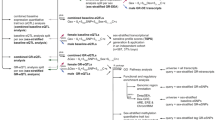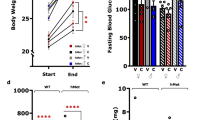Abstract
Major depressive disorder (MDD) constitutes a major public health problem worldwide and affects women twice as frequently as men. Previous genetic studies have revealed significant evidence of linkage of the cAMP-responsive element-binding protein 1 (CREB1) gene region (2q33–35) to mood disorders among women from families with recurrent, early-onset MDD (RE-MDD), a severe and familial subtype of MDD. A rare G-to-A transition at position −656 in the CREB1 promoter co-segregates with mood disorders in women from these families, implicating CREB1 as a sex-related susceptibility gene for unipolar mood disorders. In the current study, the functional significance of the CREB1 promoter variant was determined using transfection experiments that employed plasmid constructs containing the wild-type or variant CREB1 promoters coupled to a reporter gene. The results support the hypothesis that the A−656 allele contributes to the development of MDD in women through selective alteration of CREB1 promoter activity by female gonadal steroids in noradrenergic neuronal cells. Furthermore, exaggeration of these effects during a simulated stress condition may be relevant to reported gene–environment interactions that contribute to the emergence of MDD in clinical populations.
This is a preview of subscription content, access via your institution
Access options
Subscribe to this journal
Receive 12 print issues and online access
$259.00 per year
only $21.58 per issue
Buy this article
- Purchase on Springer Link
- Instant access to full article PDF
Prices may be subject to local taxes which are calculated during checkout



Similar content being viewed by others
References
Zubenko GS, Zubenko WN, Spiker DG, Giles DE, Kaplan BB . The malignancy of recurrent, early-onset major depression: a family study. Am J Med Genet Neuropsychiatr Genet 2001; 105: 690–699.
Maher BS, Marazita ML, Zubenko WN, Spiker DG, Giles DE, Kaplan BB et al. Genetic segregation analysis of recurrent, early-onset major depression: evidence for single major locus transmission. Am J Med Genet Neuropsychiatr Genet 2002; 114: 214–221.
Zubenko GS, Hughes HB, Stiffler JS, Zubenko WN, Kaplan BB . Genome survey for susceptibility loci for recurrent, early-onset major depression: results at 10 cM resolution. Am J Med Genet Neuropsychiatr Genet 2002; 114: 413–422.
Philibert R, Caspers K, Langbehn D, Troughton EP, Yucuis R, Sandhu HK et al. The association of the D2S2944 124 bp allele with recurrent early onset major depressive disorder in women. Am J Med Genet Neuropsychiatr Genet 2003; 121: 39–43.
Zubenko GS, Hughes HB, Stiffler JS, Zubenko WN, Kaplan BB . D2S2944 identifies a likely susceptibility locus for recurrent, early-onset, major depression in women. Mol Psychiatry 2002; 7: 460–467.
Zubenko GS, Hughes III HB, Maher BS, Stiffler JS, Zubenko WN, Marazita ML . Genetic linkage of region containing the CREB1 gene to depressive disorders in women from families with recurrent, early-onset, major depression. Am J Med Genet Neuropsychiatr Genet 2002; 114: 980–987.
Zubenko GS, Maher BS, Hughes III HB, Zubenko WN, Stiffler JSS, Kaplan BB et al. Genome-wide linkage survey for genetic loci that influence the development of depressive disorders in families with recurrent, early-onset, major depression. Am J Med Genet Neuropsychiatr Genet 2003; 123B: 1–18.
Manji HK, Drevets WC, Charney DS . The cellular neurobiology of depression. Nat Med 2001; 7: 541–547.
Nestler EJ, Barrot M, DiLeone RJ, Eisch AJ, Gold SJ, Monteggia LM . Neurobiology of depression. Neuron 2002; 34: 13–25.
Carlezon Jr WA, Duman RS, Nestler EJ . The many faces of CREB. Trends Neurosci 2005; 28: 436–445.
Mayr B, Montminy M . Transcriptional regulation by the phosphorylation-dependent factor CREB. Mol Cell Biol 2001; 2: 599–609.
Weeber EJ, Sweatt JD . Molecular biology of human cognition. Neuron 2002; 33: 845–848.
Zubenko GS . Do susceptibility loci contribute to the expression of more than one mental disorder? A view from the genetics of Alzheimer's disease. Mol Psychiatry 2000; 5: 131–136.
Lazennec G, Thomas JA, Katznellenbogen BS . Involvement of cyclic AMP response element binding protein (CREB) and estrogen receptor phosphorylation in the synergistic activation of the estrogen receptor by estradiol and protein kinase activators. J Steroid Biochem Mol Biol 2001; 77: 193–203.
McEwen BS . Estrogens effects on the brain: multiple sites and molecular mechanisms. J Appl Physiol 2001; 91: 2785–2801.
Tremblay A, Giguere V . Contribution of steroid receptor co-activator-1 and CREB binding protein in ligand-independent activity of estrogen receptor beta. J Steroid Biochem Mol Biol 2001; 77: 19–27.
Zubenko GS, Hughes HB, Stiffler JS, Brechbiel A, Zubenko WN, Maher B et al. Sequence variations in CREB1 cosegregate with depressive disorders in women. Mol Psychiatry 2003; 8: 611–618.
Ressler KJ, Nemeroff CB . Role of norepinephrine in the pathophysiology and treatment of mood disorders. Biol Psychiatry 1999; 46: 1219–1233.
Harro J, Oreland L . Depression as a spreading adjustment disorder of monoaminergic neurons: a case for primary implication of the locus coeruleus. Brain Res Rev 2001; 38: 79–128.
Caspi A, Sugden K, Moffitt TE, Taylor A, Craig IW, Harrington H et al. Influence of life stress on depression: moderation by a polymorphism in the 5-HTT gene. Science 2003; 301: 386–389.
Suri C, Fung BP, Tischler AS, Chikaraishi DM . Catecholaminergic cell lines from the brain and adrenal glands of tyrosine hydroxylase-SV40T antigen transgenic mice. J Neurosci 1993; 13: 1280–1291.
Widnell KI, Russell DS, Nestler EJ . Regulation of expression of cAMP response element-binding protein in the locus coeruleus in vivo and in a locus coeruleus-like cell line in vitro. Proc Natl Acad Sci USA 1994; 91: 10947–10951.
Meyer TE, Waeber G, Lin J, Beckmann W, Habener JF . The promoter of the gene encoding 3′,5′-cyclic adenosine monophosphate (cAMP) response element binding protein contains cAMP response elements: evidence for positive autoregulation of gene transcription. Endocrinology 1993; 132: 770–780.
Walker WH, Fucci L, Habener JF . Expression of the gene encoding transcription factor cyclic adenosine 3′,5′-monophosphate (cAMP) response element binding protein (CREB); regulation by follicle-stimulating hormone-induced cAMP signaling in primary rat Sertoli cells. Endocrinology 1995; 136: 3534–3545.
Widnell KI, Chen J-S, Iredale PA, Walker WH, Duman RS, Habener JF et al. Transcriptional regulation of CREB (cyclic AMP response element-binding protein) expression in CATH.a cells. J Neurochem 1996; 66: 1770–1773.
Coven E, Ni Y, Widnell KI, Chen J, Walker WH, Habener JF et al. Cell type-specific regulation of CREB gene expression: mutational analysis of CREB promoter activity. J Neurochem 1998; 71: 1865–1874.
Delfino FJ, Walker WH . NF-κB induces cAMP-response element-binding protein gene transcription in Sertoli cells. J Biol Chem 1999; 274: 35607–35613.
Shell SA, Fix C, Olejniczak D, Gram-Humphrey N, Walker WH . Regulation of cyclic adenosine 3′,5′-monophosphate response element binding protein (CREB) expression by Sp1 in the mammalian testes. Biol Reprod 2002; 66: 659–666.
Cornil CA, Ball GF, Balthazart J . Functional significance of the rapid regulation of brain estrogen action: where do the estrogens come from? Brain Res 2006; 1126: 2–26.
Zubenko GS, Hughes III HB . Effects of the G(−656)A variant on CREB1 promoter activity in a glial cell line: interactions with gonadal steroids and stress. Am J Med Genet Neuropsychiatr Genet 2008 (in press).
Lau KF, Miller CC, Anderton BH, Shaw PC . Molecular cloning and characterization of the human glycogen synthase kinase-3 beta promoter. Genomics 1999; 60: 121–128.
Bhat RV, Budd Haeberlein SL, Avila J . Glycogen synthase kinase 3: a drug target for CNS therapies. J Neurochem 2004; 89: 313–1317.
Jope RS, Yuskaitis CJ, Beurel E . Glycogen synthase kinase-3 (GSK3): Inflammation, diseases, and therapeutics. Neurochem Res 2007; 32: 577–595.
Schahab S, Heun R, Schmitz S, Maier W, Kölsch H . Association of polymorphism in the transcription factor LBP-1c/CP2/LSF gene with Alzheimer's disease and major depression. Dement Geriatr Cogn Disord 2006; 22: 95–98.
Lambert J-C, Goumidi L, Wavrant-De Vrieze F, Frigard B, Harris JM, Cummings A et al. The transcriptional factor LBP-1c/CP2/LSF gene on chromosome 12 is a genetic determinant of Alzheimer's disease. Hum Mole Genet 2000; 9: 2275–2280.
McEwen BS, Alves SE . Estrogen actions in the central nervous system. Endocr Rev 1999; 20: 279–307.
Perlis RH, Purcell S, Fagerness J, Cusin C, Yamaki L, Fava M et al. Clinical and genetic dissection of anger expression and CREB1 polymorphisms in major depressive disorder. Biol Psychiatry 2007; 62: 536–540.
Perlis RH, Purcell S, Fava M, Fagerness J, Rush AJ, Trivedi MH et al. Association between treatment-emergent suicidal ideation with citalipram and polymorphisms near cyclic adenosine monophosphate response element binding protein in the STAR*D Study. Arch Gen Psychiatry 2007; 64: 689–697.
Acknowledgements
This work was supported by research project Grants MH43261, MH60866 and MH47346 from the National Institute of Mental Health (GSZ).
Author information
Authors and Affiliations
Corresponding author
Rights and permissions
About this article
Cite this article
Zubenko, G., Hughes, H. Effects of the G(−656)A variant on CREB1 promoter activity in a neuronal cell line: Interactions with gonadal steroids and stress. Mol Psychiatry 14, 390–397 (2009). https://doi.org/10.1038/mp.2008.23
Received:
Revised:
Accepted:
Published:
Issue Date:
DOI: https://doi.org/10.1038/mp.2008.23



